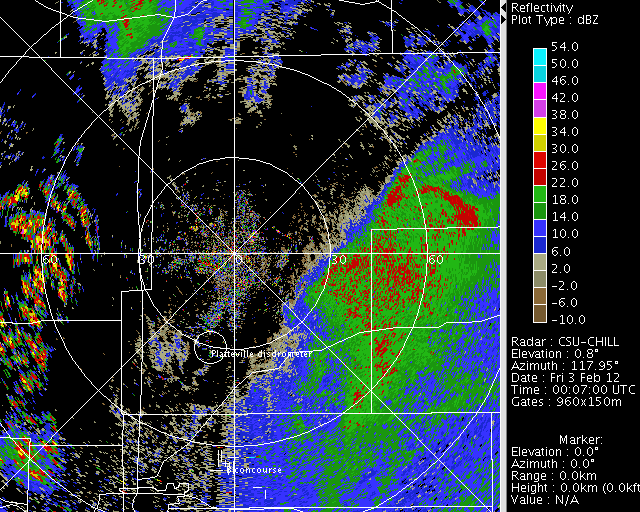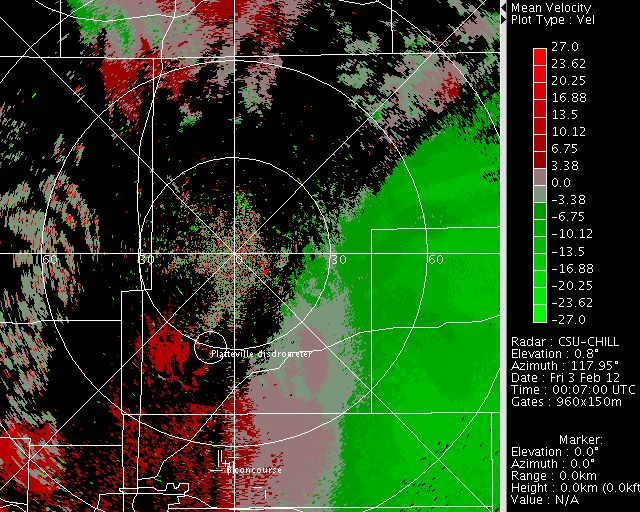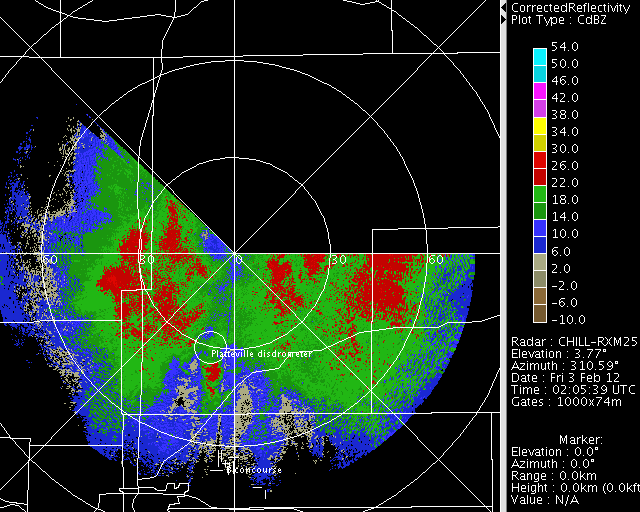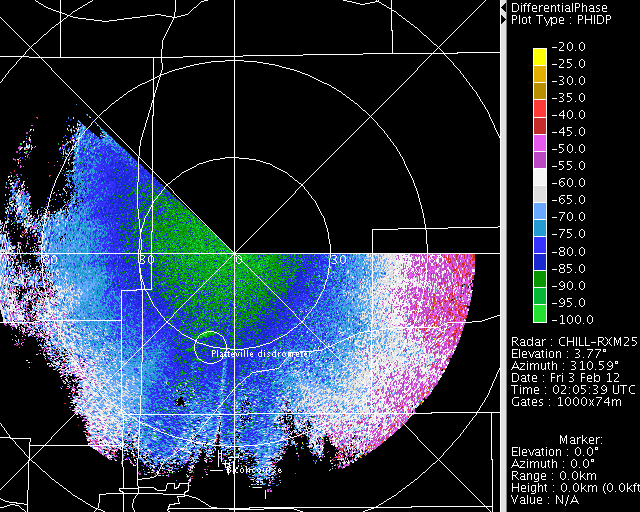X-Band Kdp observations in a snowstorm: 3 February 2012: Difference between revisions
Pat kennedy (talk | contribs) No edit summary |
Pat kennedy (talk | contribs) No edit summary |
||
| Line 1: | Line 1: | ||
==Introduction== | |||
During the 2 - 3 February 2012 period significant snowfall occurred in portions of the CSU-CHILL coverage area. This precipitation system provided an opportunity for additional test data collection with the radar operating in dual frequency (both S and X-Band) mode. The snowfall was due to a well-developed, synoptic scale upslope pattern. The color fill in the following plot shows the terrain height in the CHILL area. (Units are decameters; 120 = 1200 m above sea level). Low level air with an east to west motion component will experience lifting as it impinges on the rising terrain to the west of the radar. | |||
[[Image:Terrain CHILL anot.png|center]] | [[Image:Terrain CHILL anot.png|center]] | ||
==S-Band reflectivity loop at 0.8 degree elevation angle== | ==S-Band reflectivity loop at 0.8 degree elevation angle== | ||
The following loop shows the evolution of the S-band reflectivity field in a series of 0.8 degree PPI scans done at 10 minute intervals between 0006 and 0656 UTC. The low level echo coverage generally fills in during the early portion of the loop. The westward motion of the reflectivity features is also evident. | |||
<center> | <center> | ||
<imgloop delay=300 imgprefix="http://www.chill.colostate.edu/anim/3feb2012_X_kdp_snow/" width=640 height=512> | <imgloop delay=300 imgprefix="http://www.chill.colostate.edu/anim/3feb2012_X_kdp_snow/" width=640 height=512> | ||
| Line 47: | Line 51: | ||
==S-Band radial velocity loop at 0.8 degree elevation angle== | ==S-Band radial velocity loop at 0.8 degree elevation angle== | ||
The S-Band radial velocity pattern in the 0.8 deg PPI scans is shown in the next loop. The clockwise rotation of the 0 mps line near the radar reflects the shift in the low level wind direction from the north to the northeast that took place between frames 16 and 21 (0244 and 0351 UTC). Wind speeds also tended to increase with time after ~04 UTC. | |||
<center> | <center> | ||
<imgloop delay=300 imgprefix="http://www.chill.colostate.edu/anim/3feb2012_X_kdp_snow/" width=640 height=512> | <imgloop delay=300 imgprefix="http://www.chill.colostate.edu/anim/3feb2012_X_kdp_snow/" width=640 height=512> | ||
| Line 92: | Line 98: | ||
==X-Band corrected reflectivity loop at 2.8 degree elevation angle== | ==X-Band corrected reflectivity loop at 2.8 degree elevation angle== | ||
Following the single 0.8 degree full 360 PPI scan, a wide sector scan was done at a series of higher elevation angles. The following loop shows the X-Band attenuation-corrected reflectivity data in the 2.8 degree PPI sweeps between 0205 and 0640 UTC. (The elevation angle shown in the annotation block exceed 2.8 degrees because the antenna had starting moving up to execute the next sweep.) Reflectivity enhancement occurred over the foothills of Larimer and Boulder Counties in the northwest and southwest azimuth qudrants from the radar. | |||
<center> | <center> | ||
<imgloop delay=300 imgprefix="http://www.chill.colostate.edu/anim/3feb2012_X_kdp_snow/" width=640 height=512> | <imgloop delay=300 imgprefix="http://www.chill.colostate.edu/anim/3feb2012_X_kdp_snow/" width=640 height=512> | ||
| Line 124: | Line 132: | ||
==X-Band differential propagation phase loop at 2.8 degree elevation angle== | ==X-Band differential propagation phase loop at 2.8 degree elevation angle== | ||
The evolution of the X-Band differential propagation phase (phidp) field on the 2.8 degree PPI surface is shown below. Range intervals over which the color sequence moves up the color scale indicate that the presence of a significant concentration of horizontally-oriented ice particles is retarding the propagation of the H polarized waves relative to the V waves. Most of these high phase shift areas occurred in the region of orced lifting above the foothills. | |||
<center> | <center> | ||
<imgloop delay=300 imgprefix="http://www.chill.colostate.edu/anim/3feb2012_X_kdp_snow/" width=640 height=512> | <imgloop delay=300 imgprefix="http://www.chill.colostate.edu/anim/3feb2012_X_kdp_snow/" width=640 height=512> | ||
| Line 156: | Line 166: | ||
==X-Band specific differential propagation phase loop at 2.8 degree elevation angle== | ==X-Band specific differential propagation phase loop at 2.8 degree elevation angle== | ||
Specific differential propagation phase (Kdp) is the derivative of phidp with respect to range. The Kdp values shown in the following loop were calculated after a series of spatial smoothing filters were applied to the raw phidp data. Peak Kdp values approaching 2 deg / km were observed. Since Kdp is inversely proportional to the radar wavelength, the magnitudes are several times larger than those observed at S-Band (Kennedy and Rutledge, 2010). These peak values also tended to occur near 2.5 km AGL height ring. Based on the DNR sounding data, temperatures were near -15 deg C at this height level. It is suspected that the vigorous growth of dendritic ice crystals at this temperature level in the terrain-induced updrafts contributed to the large Kdp magnitudes. | |||
<center> | <center> | ||
<imgloop delay=300 imgprefix="http://www.chill.colostate.edu/anim/3feb2012_X_kdp_snow/" width=518 height=540> | <imgloop delay=300 imgprefix="http://www.chill.colostate.edu/anim/3feb2012_X_kdp_snow/" width=518 height=540> | ||
a30.png | a30.png | ||
a31.png | a31.png | ||
Revision as of 12:11, 24 February 2012
Introduction
During the 2 - 3 February 2012 period significant snowfall occurred in portions of the CSU-CHILL coverage area. This precipitation system provided an opportunity for additional test data collection with the radar operating in dual frequency (both S and X-Band) mode. The snowfall was due to a well-developed, synoptic scale upslope pattern. The color fill in the following plot shows the terrain height in the CHILL area. (Units are decameters; 120 = 1200 m above sea level). Low level air with an east to west motion component will experience lifting as it impinges on the rising terrain to the west of the radar.
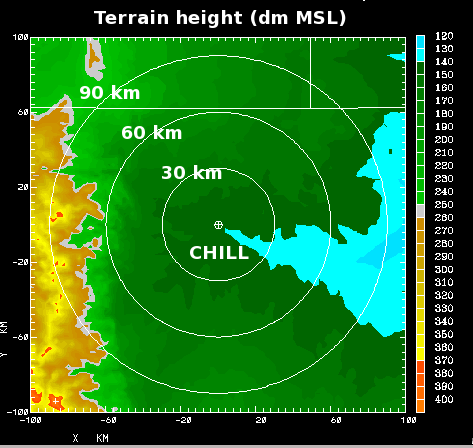
S-Band reflectivity loop at 0.8 degree elevation angle
The following loop shows the evolution of the S-band reflectivity field in a series of 0.8 degree PPI scans done at 10 minute intervals between 0006 and 0656 UTC. The low level echo coverage generally fills in during the early portion of the loop. The westward motion of the reflectivity features is also evident.
|
|
||
|
S-Band radial velocity loop at 0.8 degree elevation angle
The S-Band radial velocity pattern in the 0.8 deg PPI scans is shown in the next loop. The clockwise rotation of the 0 mps line near the radar reflects the shift in the low level wind direction from the north to the northeast that took place between frames 16 and 21 (0244 and 0351 UTC). Wind speeds also tended to increase with time after ~04 UTC.
|
|
||
|
X-Band corrected reflectivity loop at 2.8 degree elevation angle
Following the single 0.8 degree full 360 PPI scan, a wide sector scan was done at a series of higher elevation angles. The following loop shows the X-Band attenuation-corrected reflectivity data in the 2.8 degree PPI sweeps between 0205 and 0640 UTC. (The elevation angle shown in the annotation block exceed 2.8 degrees because the antenna had starting moving up to execute the next sweep.) Reflectivity enhancement occurred over the foothills of Larimer and Boulder Counties in the northwest and southwest azimuth qudrants from the radar.
|
|
||
|
X-Band differential propagation phase loop at 2.8 degree elevation angle
The evolution of the X-Band differential propagation phase (phidp) field on the 2.8 degree PPI surface is shown below. Range intervals over which the color sequence moves up the color scale indicate that the presence of a significant concentration of horizontally-oriented ice particles is retarding the propagation of the H polarized waves relative to the V waves. Most of these high phase shift areas occurred in the region of orced lifting above the foothills.
|
|
||
|
X-Band specific differential propagation phase loop at 2.8 degree elevation angle
Specific differential propagation phase (Kdp) is the derivative of phidp with respect to range. The Kdp values shown in the following loop were calculated after a series of spatial smoothing filters were applied to the raw phidp data. Peak Kdp values approaching 2 deg / km were observed. Since Kdp is inversely proportional to the radar wavelength, the magnitudes are several times larger than those observed at S-Band (Kennedy and Rutledge, 2010). These peak values also tended to occur near 2.5 km AGL height ring. Based on the DNR sounding data, temperatures were near -15 deg C at this height level. It is suspected that the vigorous growth of dendritic ice crystals at this temperature level in the terrain-induced updrafts contributed to the large Kdp magnitudes.
|
|
||
|
